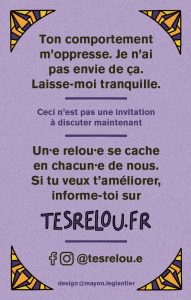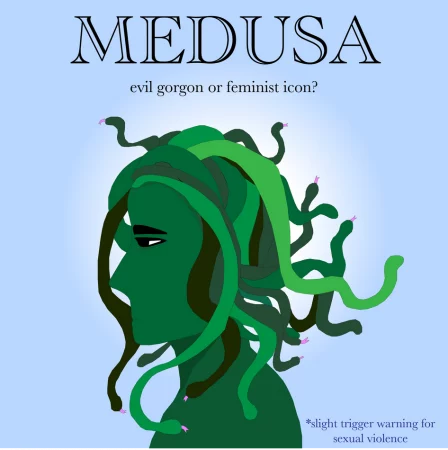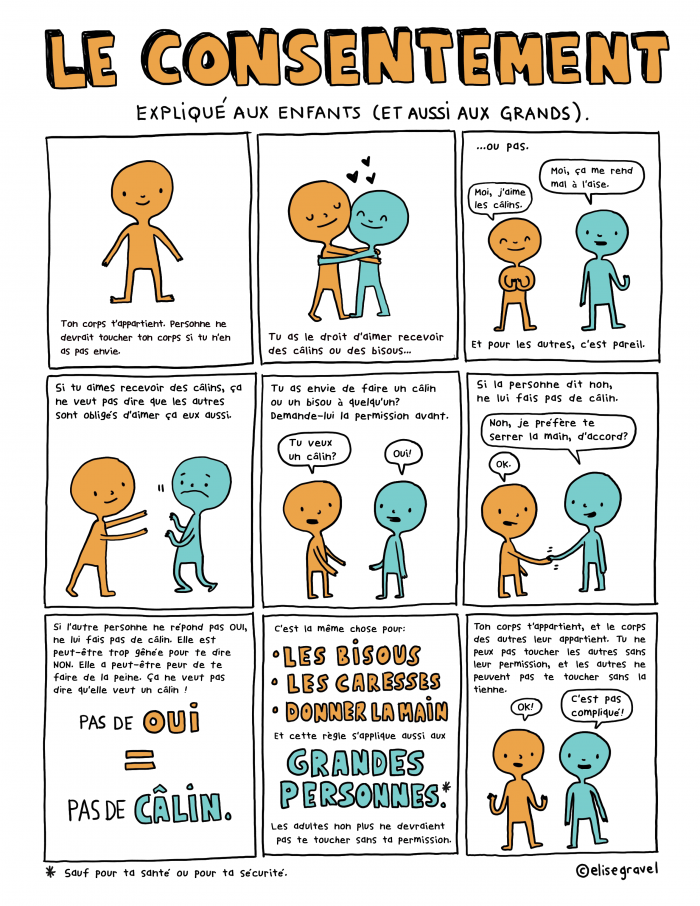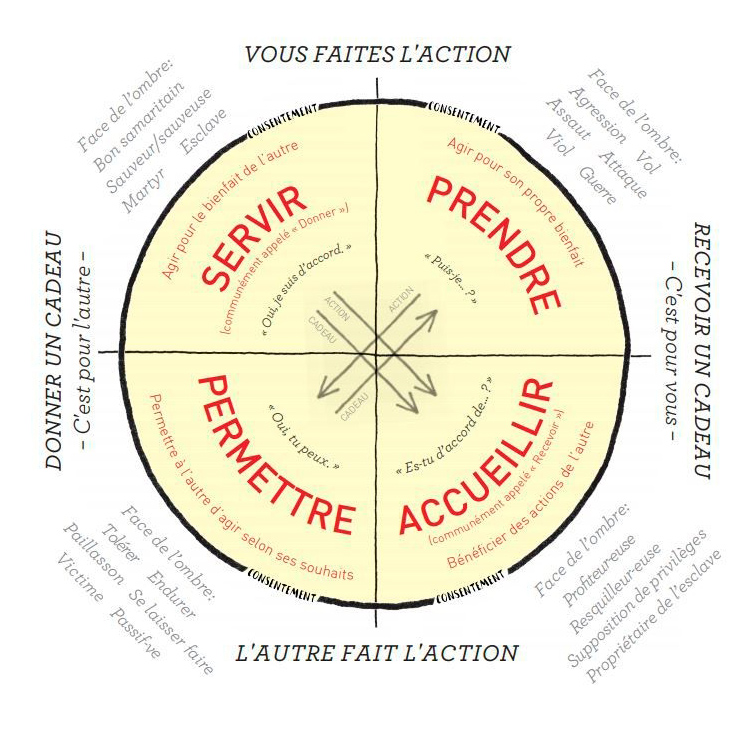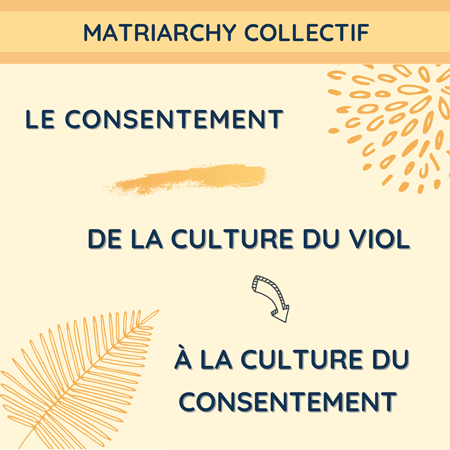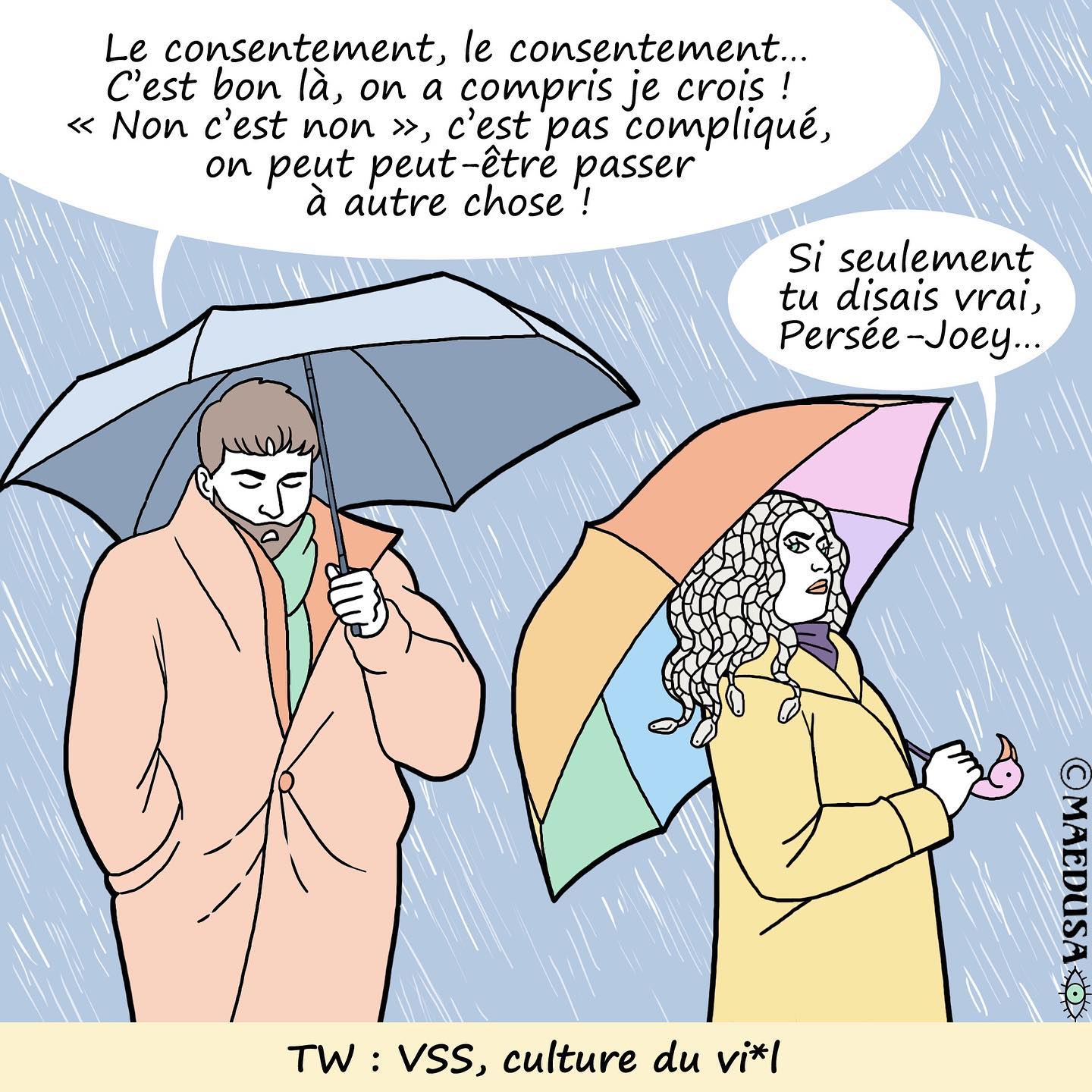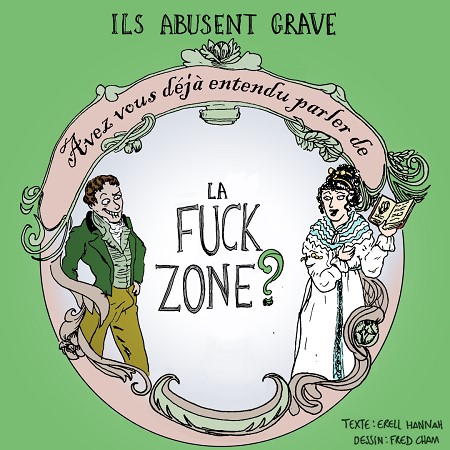Consent
We often hear that consent is “When it’s no, it’s no.” But it’s actually much more complicated than that. Hearing “no” is only the first degree in consent and a more correct formulation would be “When it’s not yes, it’s no” or even “When it’s not an enthusiastic yes, it’s an automatic no”. And still, this doesn’t take into account the possible consent biases that can push a person to say “yes” without really wanting to.
If you haven’t seen it yet, we recommend you watch this video explaining consent using the example of a cup of tea. Simple and entertaining, it’s a great place to start:
The rules of consent
To be valid, consent must be :
- Beforehand: consent must be sought before action is taken, although this does not preclude real-time verification and afterwards debriefing.
- Authentic or enthusiastic: the person must clearly give consent. An answer as “if you like” or “why not” or a lack of response is not a “yes”, it’s a “no”.
- Free: There are many biases that can push someone to say “yes” even when they don’t want to: group pressures, social norms, habit, fear of being seen as a prude or a killjoy, fear of disappointing or hurting others, a bond of authority, an aura bias, etc. And of course, consent given under physical or psychological duress is not valid.
- Lucid: a person who has consumed alcohol or other psychoactive substances may no longer be able to give consent. This is obviously even more the case if they are asleep or unconscious, or if they are underage.
- Informed: consent is not possible if one of the people is lying or deliberately concealing some of their intentions.
- Specific: consenting to something does not mean consenting to everything. For example, you may want to kiss someone, but not want to go any further. Consent is only valid at the moment it is given. Just because someone says “yes” today doesn’t necessarily mean they’ll say “yes” tomorrow.
- Revocable: one can change their mind at any time. No matter how many “yes” have been said before, everything stops at the first “no”.
We often hear the argument that constantly checking the other person’s consent makes interactions tedious and loses their naturalness. But, this is only true because we’ve all – without exception – been poorly educated to consent and have integrated as normal behaviors and reflexes that shouldn’t be. Like all learning and deconstruction, it takes time and practice to integrate it smoothly. What’s more, it’s better to take precautions, even if it takes time, than to risk unintentionally doing without the other person’s consent. There are never “too much” consent!
If you’re not sure, just ask!
Consent can be expressed in ways other than words, but it’s easy to misinterpret a gesture, a look or an expression. The best way is still to communicate verbally. Although we’ve been told since childhood romantic scripts that make us believe that everything is about innuendo, there’s nothing sexier than someone who asks clearly before kissing someone else. And making the other person understand that everything can be said and that everything will be listened to helps develop healthy, more balanced relationships.
Party consent
The list is not exhaustive, but here are a few examples that can be found in the context of a party:
- make sure the person you’re chatting or dancing with really wants to, and don’t block the possibility of leaving, even unintentionally
- never force or encourage a person to consume psychoactive products (alcohol or other drugs)
- make sure that everyone involved feels the same way, and at the same level of intensity.
- never put your hand on another person’s shoulder (or any other part of their body) without expressly asking permission. Tactile people tend to make this gesture mechanically, without thinking about it. This can be very oppressive for some people, even if there’s no ulterior motive. When you’re weaving your way through a crowd and need to touch people to protect yourself, avoid collisions or simply get through, place your hand lightly at shoulder level, not waist level, and do so without grabbing.
Towards a culture of consent
Learning to express consent
Before being given to people who do not respect consent, the “I have said no” card can be first given to yourself, to remind you that consent already begins with your own. Many people have not learned to set limits, or even to recognize them. And beyond limits (“what I don’t want”), there’s also the question of desires (“what I want”), which can sometimes be complex, especially for sexified people who have been brought up to be reactive to men’s desires.
However, expressing our limits is a gift we give ourselves, by not imposing on ourselves something we don’t want. It’s also a gift we give to others because, apart from predatory behavior, no one wants to interact with someone else without their consent. Saying you don’t want something is therefore a double gift, to yourself and to the other person. Why deprive yourself? The same reasoning can be applied to expressing your desires and wishes.
Because a “no” is a gift, we should always thank someone who tells their own limits, especially as it’s not always easy to do, and requires courage and energy.
Setting up an environment conducive to consent
It’s only possible to express one’s limits, desires and wishes if the environment allows it. As we saw earlier, many biases can influence consent. For example, requiring a person to make a decision immediately may lead them to make a choice they would not otherwise have made. Moreover, many people, especially sexified person, have had negative or even traumatic experiences when setting up limits in the past. Sometime, those limits were not respected. But it can be as well a change of disposition towards them, for instance when the other person realize that they are not going to be intimate (the famous fuck zone concept). Or someone else who develops resentment towards them simply because it’s easier than admitting they’ve screwed up.
When asking for consent, it’s therefore important to set a reassuring environment, indicating that any response is acceptable and will be accepted, and that a negative response will not result in a change of disposition towards them. In fact, the first question may be to ask whether or not they have difficulty in saying “no”, and to adapt your behavior accordingly.
It’s only once this environment has been established that you can fully leave the responsibility for consent to the other person, without infantilizing them or making decisions for them. Everyone is responsible for their own consent, but everyone is also responsible for creating an environment in which the other person’s consent can be expressed.
A “yes” only has value if a “no” is possible. And knowing that you can say “no” at any time, and that it will be heard and respected, sometimes makes you want to say “yes”.
Small tip
It’s easier to answer “yes” than “no”. When you are feeling that your partner is not okay with an ongoing activity (sexual or otherwise), you can ask them “Do you want to stop?” rather than “Do you want to continue?”. If ever they don’t feel like continuing, it will always be easier to express it with the first formulation, as the question implies that stopping the interaction is an entirely feasible option.
The myth of Medusa
We’re often asked why we chose Medusa as the figure for the “I have said no” card. Starting from a misogynist myth in which Medusa is portrayed alternately as a helpless victim or an evil monster, Medusa has gradually become a feminist icon who overturns tropes, those sexist narrative clichés. While society and men constantly objectify her, Medusa asserts her role as an active, desiring and acting subject. From “male gaze” to “female gaze”. And when confronted with those who objectify her through their gaze, she transforms them back into stone statues, so literally into objects!
To find out more, you’ll find a summary of the Medusa myth and its feminist reinterpretation on the comic Medusa: Evil Gorgon or Feminist Icon?
Pour approfondir le sujet
Il existe de très nombreuses autres ressources sur le net. En voici une petite sélection :


